Evaluating Nurse to Patient Ratio for Patient Safety and Outcomes
VerifiedAdded on 2022/11/01
|8
|2337
|415
Presentation
AI Summary
This presentation delves into the critical issue of nurse-to-patient ratios and their profound impact on patient safety and healthcare outcomes. The presentation highlights the ideal nurse-to-patient ratios in various healthcare settings, such as emergency departments and critical care units, and compares them to the often-inadequate actual ratios. It explores the adverse effects of reduced nurse staffing, including increased mortality rates, extended hospital stays, reduced patient satisfaction, and a rise in medication errors. The presentation further examines the negative consequences on nurses, such as fatigue and increased workloads, contributing to nurse turnover. The presentation advocates for strategies to improve nurse-to-patient ratios, including increased hiring of registered nurses, and addresses leadership roles in promoting clinical knowledge and addressing issues like low wages. Furthermore, the presentation emphasizes the importance of evidence-based practices, including peer-reviewed articles and surveys, to provide a comprehensive understanding of the subject. The ultimate goal is to raise awareness of the significance of nurse-to-patient ratios, their impact on patient safety, and strategies to improve the issue.
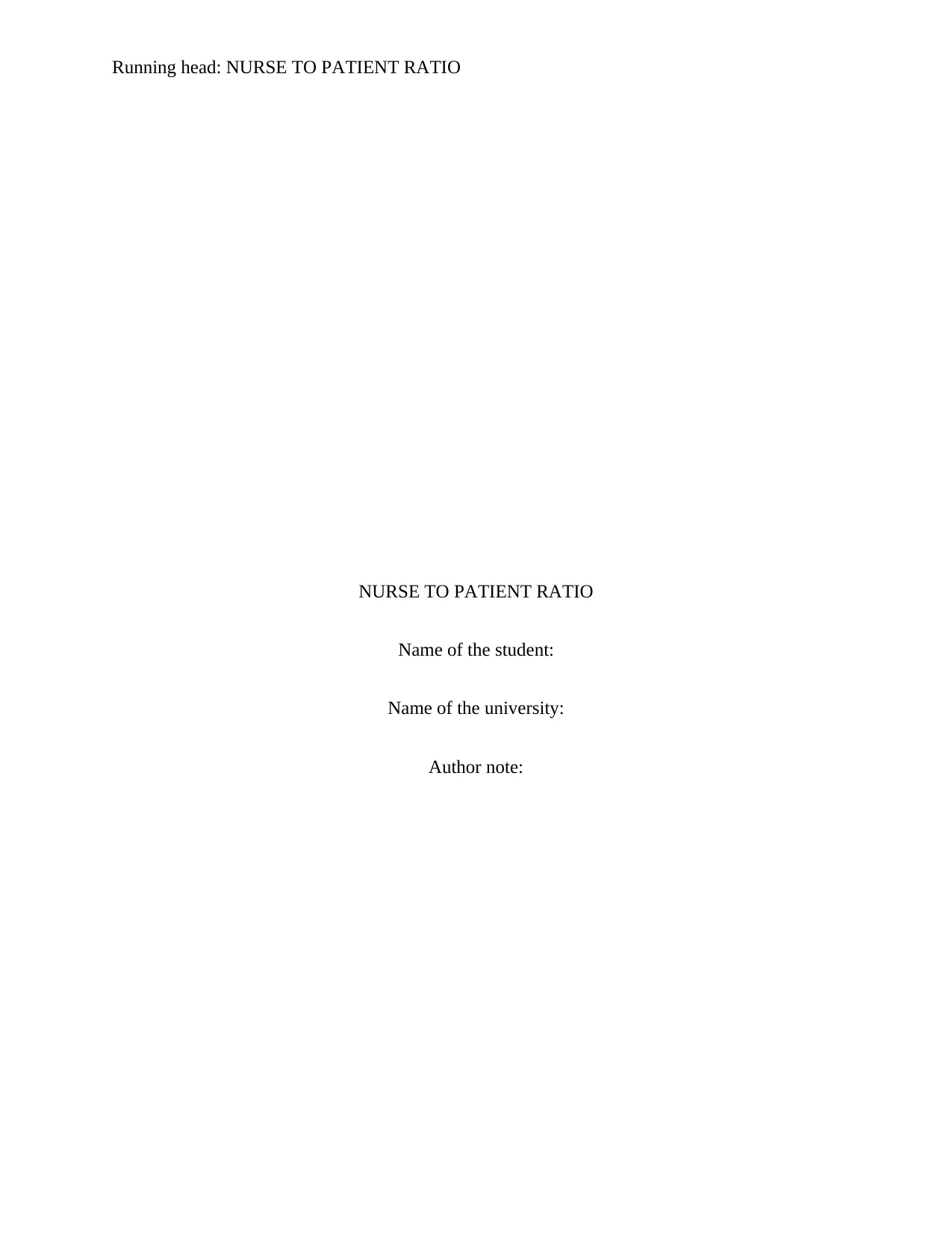
Running head: NURSE TO PATIENT RATIO
NURSE TO PATIENT RATIO
Name of the student:
Name of the university:
Author note:
NURSE TO PATIENT RATIO
Name of the student:
Name of the university:
Author note:
Paraphrase This Document
Need a fresh take? Get an instant paraphrase of this document with our AI Paraphraser
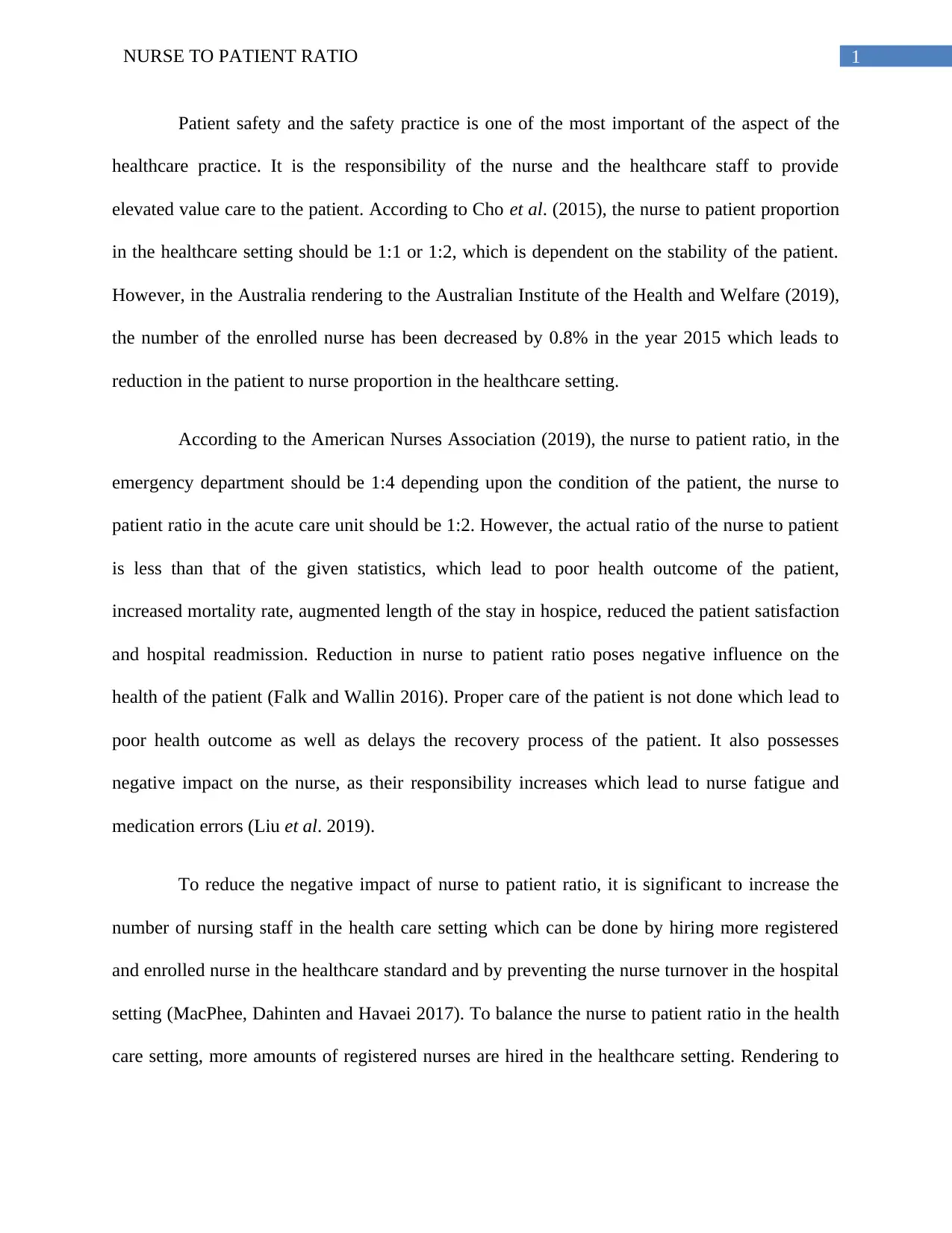
1NURSE TO PATIENT RATIO
Patient safety and the safety practice is one of the most important of the aspect of the
healthcare practice. It is the responsibility of the nurse and the healthcare staff to provide
elevated value care to the patient. According to Cho et al. (2015), the nurse to patient proportion
in the healthcare setting should be 1:1 or 1:2, which is dependent on the stability of the patient.
However, in the Australia rendering to the Australian Institute of the Health and Welfare (2019),
the number of the enrolled nurse has been decreased by 0.8% in the year 2015 which leads to
reduction in the patient to nurse proportion in the healthcare setting.
According to the American Nurses Association (2019), the nurse to patient ratio, in the
emergency department should be 1:4 depending upon the condition of the patient, the nurse to
patient ratio in the acute care unit should be 1:2. However, the actual ratio of the nurse to patient
is less than that of the given statistics, which lead to poor health outcome of the patient,
increased mortality rate, augmented length of the stay in hospice, reduced the patient satisfaction
and hospital readmission. Reduction in nurse to patient ratio poses negative influence on the
health of the patient (Falk and Wallin 2016). Proper care of the patient is not done which lead to
poor health outcome as well as delays the recovery process of the patient. It also possesses
negative impact on the nurse, as their responsibility increases which lead to nurse fatigue and
medication errors (Liu et al. 2019).
To reduce the negative impact of nurse to patient ratio, it is significant to increase the
number of nursing staff in the health care setting which can be done by hiring more registered
and enrolled nurse in the healthcare standard and by preventing the nurse turnover in the hospital
setting (MacPhee, Dahinten and Havaei 2017). To balance the nurse to patient ratio in the health
care setting, more amounts of registered nurses are hired in the healthcare setting. Rendering to
Patient safety and the safety practice is one of the most important of the aspect of the
healthcare practice. It is the responsibility of the nurse and the healthcare staff to provide
elevated value care to the patient. According to Cho et al. (2015), the nurse to patient proportion
in the healthcare setting should be 1:1 or 1:2, which is dependent on the stability of the patient.
However, in the Australia rendering to the Australian Institute of the Health and Welfare (2019),
the number of the enrolled nurse has been decreased by 0.8% in the year 2015 which leads to
reduction in the patient to nurse proportion in the healthcare setting.
According to the American Nurses Association (2019), the nurse to patient ratio, in the
emergency department should be 1:4 depending upon the condition of the patient, the nurse to
patient ratio in the acute care unit should be 1:2. However, the actual ratio of the nurse to patient
is less than that of the given statistics, which lead to poor health outcome of the patient,
increased mortality rate, augmented length of the stay in hospice, reduced the patient satisfaction
and hospital readmission. Reduction in nurse to patient ratio poses negative influence on the
health of the patient (Falk and Wallin 2016). Proper care of the patient is not done which lead to
poor health outcome as well as delays the recovery process of the patient. It also possesses
negative impact on the nurse, as their responsibility increases which lead to nurse fatigue and
medication errors (Liu et al. 2019).
To reduce the negative impact of nurse to patient ratio, it is significant to increase the
number of nursing staff in the health care setting which can be done by hiring more registered
and enrolled nurse in the healthcare standard and by preventing the nurse turnover in the hospital
setting (MacPhee, Dahinten and Havaei 2017). To balance the nurse to patient ratio in the health
care setting, more amounts of registered nurses are hired in the healthcare setting. Rendering to
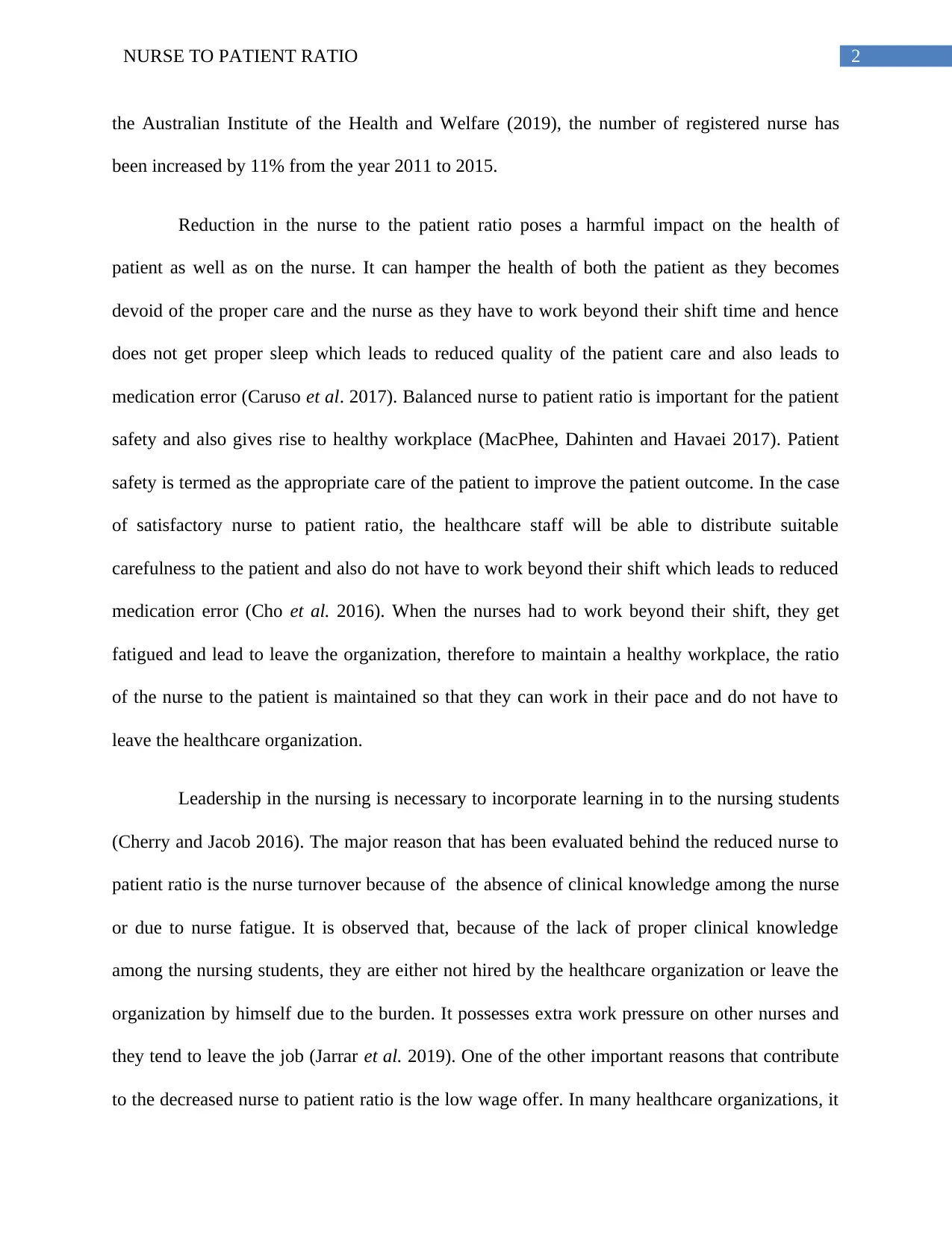
2NURSE TO PATIENT RATIO
the Australian Institute of the Health and Welfare (2019), the number of registered nurse has
been increased by 11% from the year 2011 to 2015.
Reduction in the nurse to the patient ratio poses a harmful impact on the health of
patient as well as on the nurse. It can hamper the health of both the patient as they becomes
devoid of the proper care and the nurse as they have to work beyond their shift time and hence
does not get proper sleep which leads to reduced quality of the patient care and also leads to
medication error (Caruso et al. 2017). Balanced nurse to patient ratio is important for the patient
safety and also gives rise to healthy workplace (MacPhee, Dahinten and Havaei 2017). Patient
safety is termed as the appropriate care of the patient to improve the patient outcome. In the case
of satisfactory nurse to patient ratio, the healthcare staff will be able to distribute suitable
carefulness to the patient and also do not have to work beyond their shift which leads to reduced
medication error (Cho et al. 2016). When the nurses had to work beyond their shift, they get
fatigued and lead to leave the organization, therefore to maintain a healthy workplace, the ratio
of the nurse to the patient is maintained so that they can work in their pace and do not have to
leave the healthcare organization.
Leadership in the nursing is necessary to incorporate learning in to the nursing students
(Cherry and Jacob 2016). The major reason that has been evaluated behind the reduced nurse to
patient ratio is the nurse turnover because of the absence of clinical knowledge among the nurse
or due to nurse fatigue. It is observed that, because of the lack of proper clinical knowledge
among the nursing students, they are either not hired by the healthcare organization or leave the
organization by himself due to the burden. It possesses extra work pressure on other nurses and
they tend to leave the job (Jarrar et al. 2019). One of the other important reasons that contribute
to the decreased nurse to patient ratio is the low wage offer. In many healthcare organizations, it
the Australian Institute of the Health and Welfare (2019), the number of registered nurse has
been increased by 11% from the year 2011 to 2015.
Reduction in the nurse to the patient ratio poses a harmful impact on the health of
patient as well as on the nurse. It can hamper the health of both the patient as they becomes
devoid of the proper care and the nurse as they have to work beyond their shift time and hence
does not get proper sleep which leads to reduced quality of the patient care and also leads to
medication error (Caruso et al. 2017). Balanced nurse to patient ratio is important for the patient
safety and also gives rise to healthy workplace (MacPhee, Dahinten and Havaei 2017). Patient
safety is termed as the appropriate care of the patient to improve the patient outcome. In the case
of satisfactory nurse to patient ratio, the healthcare staff will be able to distribute suitable
carefulness to the patient and also do not have to work beyond their shift which leads to reduced
medication error (Cho et al. 2016). When the nurses had to work beyond their shift, they get
fatigued and lead to leave the organization, therefore to maintain a healthy workplace, the ratio
of the nurse to the patient is maintained so that they can work in their pace and do not have to
leave the healthcare organization.
Leadership in the nursing is necessary to incorporate learning in to the nursing students
(Cherry and Jacob 2016). The major reason that has been evaluated behind the reduced nurse to
patient ratio is the nurse turnover because of the absence of clinical knowledge among the nurse
or due to nurse fatigue. It is observed that, because of the lack of proper clinical knowledge
among the nursing students, they are either not hired by the healthcare organization or leave the
organization by himself due to the burden. It possesses extra work pressure on other nurses and
they tend to leave the job (Jarrar et al. 2019). One of the other important reasons that contribute
to the decreased nurse to patient ratio is the low wage offer. In many healthcare organizations, it
⊘ This is a preview!⊘
Do you want full access?
Subscribe today to unlock all pages.

Trusted by 1+ million students worldwide
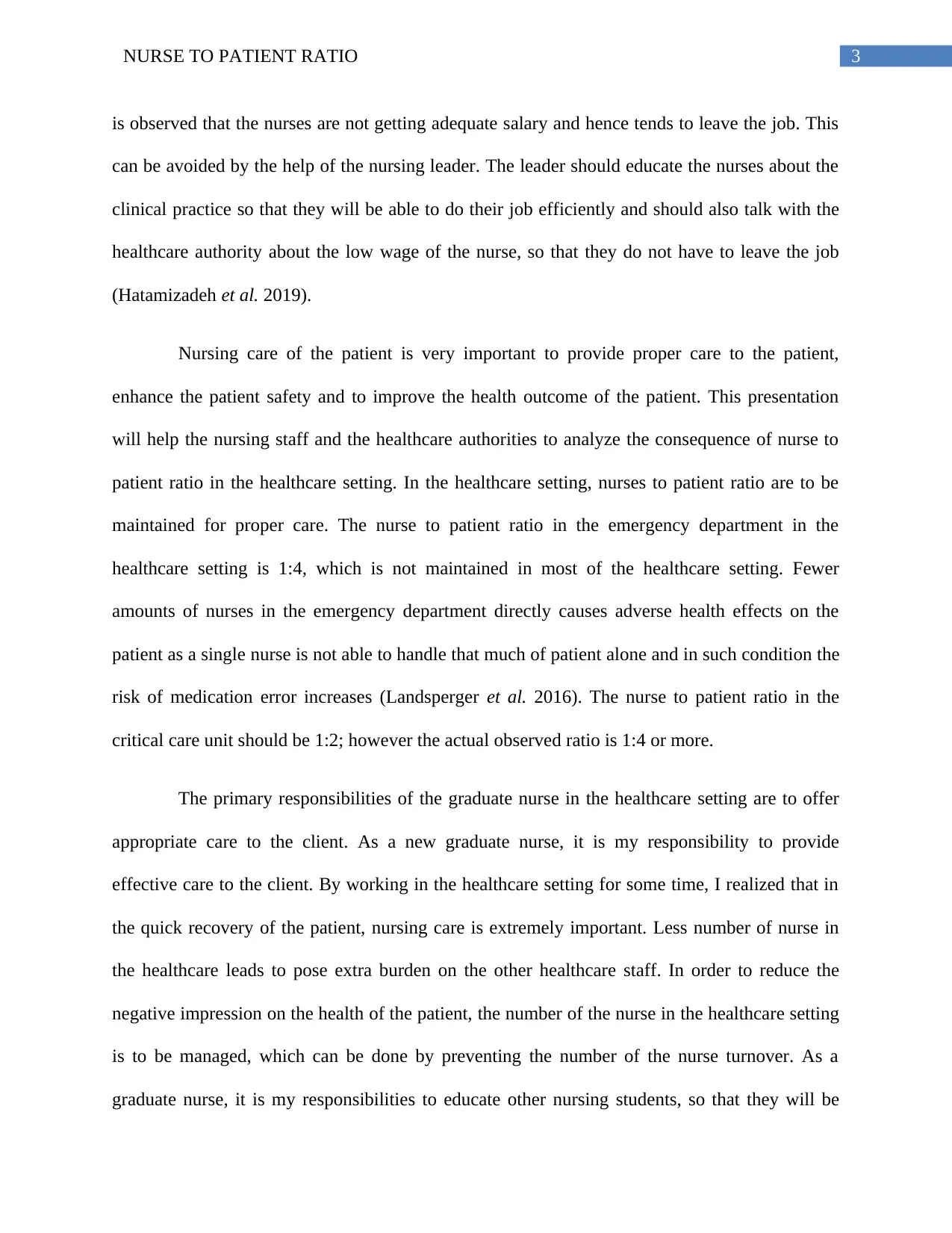
3NURSE TO PATIENT RATIO
is observed that the nurses are not getting adequate salary and hence tends to leave the job. This
can be avoided by the help of the nursing leader. The leader should educate the nurses about the
clinical practice so that they will be able to do their job efficiently and should also talk with the
healthcare authority about the low wage of the nurse, so that they do not have to leave the job
(Hatamizadeh et al. 2019).
Nursing care of the patient is very important to provide proper care to the patient,
enhance the patient safety and to improve the health outcome of the patient. This presentation
will help the nursing staff and the healthcare authorities to analyze the consequence of nurse to
patient ratio in the healthcare setting. In the healthcare setting, nurses to patient ratio are to be
maintained for proper care. The nurse to patient ratio in the emergency department in the
healthcare setting is 1:4, which is not maintained in most of the healthcare setting. Fewer
amounts of nurses in the emergency department directly causes adverse health effects on the
patient as a single nurse is not able to handle that much of patient alone and in such condition the
risk of medication error increases (Landsperger et al. 2016). The nurse to patient ratio in the
critical care unit should be 1:2; however the actual observed ratio is 1:4 or more.
The primary responsibilities of the graduate nurse in the healthcare setting are to offer
appropriate care to the client. As a new graduate nurse, it is my responsibility to provide
effective care to the client. By working in the healthcare setting for some time, I realized that in
the quick recovery of the patient, nursing care is extremely important. Less number of nurse in
the healthcare leads to pose extra burden on the other healthcare staff. In order to reduce the
negative impression on the health of the patient, the number of the nurse in the healthcare setting
is to be managed, which can be done by preventing the number of the nurse turnover. As a
graduate nurse, it is my responsibilities to educate other nursing students, so that they will be
is observed that the nurses are not getting adequate salary and hence tends to leave the job. This
can be avoided by the help of the nursing leader. The leader should educate the nurses about the
clinical practice so that they will be able to do their job efficiently and should also talk with the
healthcare authority about the low wage of the nurse, so that they do not have to leave the job
(Hatamizadeh et al. 2019).
Nursing care of the patient is very important to provide proper care to the patient,
enhance the patient safety and to improve the health outcome of the patient. This presentation
will help the nursing staff and the healthcare authorities to analyze the consequence of nurse to
patient ratio in the healthcare setting. In the healthcare setting, nurses to patient ratio are to be
maintained for proper care. The nurse to patient ratio in the emergency department in the
healthcare setting is 1:4, which is not maintained in most of the healthcare setting. Fewer
amounts of nurses in the emergency department directly causes adverse health effects on the
patient as a single nurse is not able to handle that much of patient alone and in such condition the
risk of medication error increases (Landsperger et al. 2016). The nurse to patient ratio in the
critical care unit should be 1:2; however the actual observed ratio is 1:4 or more.
The primary responsibilities of the graduate nurse in the healthcare setting are to offer
appropriate care to the client. As a new graduate nurse, it is my responsibility to provide
effective care to the client. By working in the healthcare setting for some time, I realized that in
the quick recovery of the patient, nursing care is extremely important. Less number of nurse in
the healthcare leads to pose extra burden on the other healthcare staff. In order to reduce the
negative impression on the health of the patient, the number of the nurse in the healthcare setting
is to be managed, which can be done by preventing the number of the nurse turnover. As a
graduate nurse, it is my responsibilities to educate other nursing students, so that they will be
Paraphrase This Document
Need a fresh take? Get an instant paraphrase of this document with our AI Paraphraser
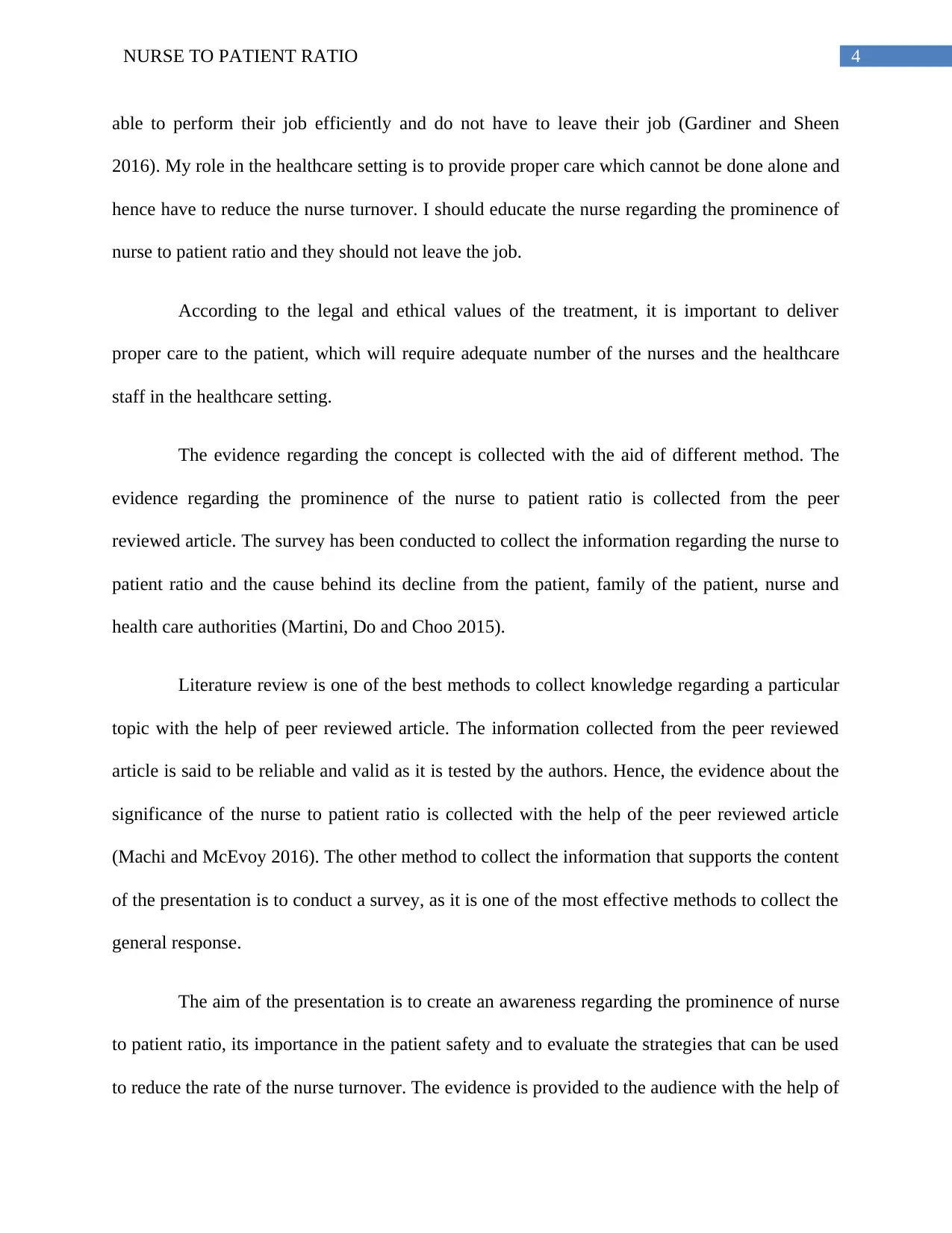
4NURSE TO PATIENT RATIO
able to perform their job efficiently and do not have to leave their job (Gardiner and Sheen
2016). My role in the healthcare setting is to provide proper care which cannot be done alone and
hence have to reduce the nurse turnover. I should educate the nurse regarding the prominence of
nurse to patient ratio and they should not leave the job.
According to the legal and ethical values of the treatment, it is important to deliver
proper care to the patient, which will require adequate number of the nurses and the healthcare
staff in the healthcare setting.
The evidence regarding the concept is collected with the aid of different method. The
evidence regarding the prominence of the nurse to patient ratio is collected from the peer
reviewed article. The survey has been conducted to collect the information regarding the nurse to
patient ratio and the cause behind its decline from the patient, family of the patient, nurse and
health care authorities (Martini, Do and Choo 2015).
Literature review is one of the best methods to collect knowledge regarding a particular
topic with the help of peer reviewed article. The information collected from the peer reviewed
article is said to be reliable and valid as it is tested by the authors. Hence, the evidence about the
significance of the nurse to patient ratio is collected with the help of the peer reviewed article
(Machi and McEvoy 2016). The other method to collect the information that supports the content
of the presentation is to conduct a survey, as it is one of the most effective methods to collect the
general response.
The aim of the presentation is to create an awareness regarding the prominence of nurse
to patient ratio, its importance in the patient safety and to evaluate the strategies that can be used
to reduce the rate of the nurse turnover. The evidence is provided to the audience with the help of
able to perform their job efficiently and do not have to leave their job (Gardiner and Sheen
2016). My role in the healthcare setting is to provide proper care which cannot be done alone and
hence have to reduce the nurse turnover. I should educate the nurse regarding the prominence of
nurse to patient ratio and they should not leave the job.
According to the legal and ethical values of the treatment, it is important to deliver
proper care to the patient, which will require adequate number of the nurses and the healthcare
staff in the healthcare setting.
The evidence regarding the concept is collected with the aid of different method. The
evidence regarding the prominence of the nurse to patient ratio is collected from the peer
reviewed article. The survey has been conducted to collect the information regarding the nurse to
patient ratio and the cause behind its decline from the patient, family of the patient, nurse and
health care authorities (Martini, Do and Choo 2015).
Literature review is one of the best methods to collect knowledge regarding a particular
topic with the help of peer reviewed article. The information collected from the peer reviewed
article is said to be reliable and valid as it is tested by the authors. Hence, the evidence about the
significance of the nurse to patient ratio is collected with the help of the peer reviewed article
(Machi and McEvoy 2016). The other method to collect the information that supports the content
of the presentation is to conduct a survey, as it is one of the most effective methods to collect the
general response.
The aim of the presentation is to create an awareness regarding the prominence of nurse
to patient ratio, its importance in the patient safety and to evaluate the strategies that can be used
to reduce the rate of the nurse turnover. The evidence is provided to the audience with the help of
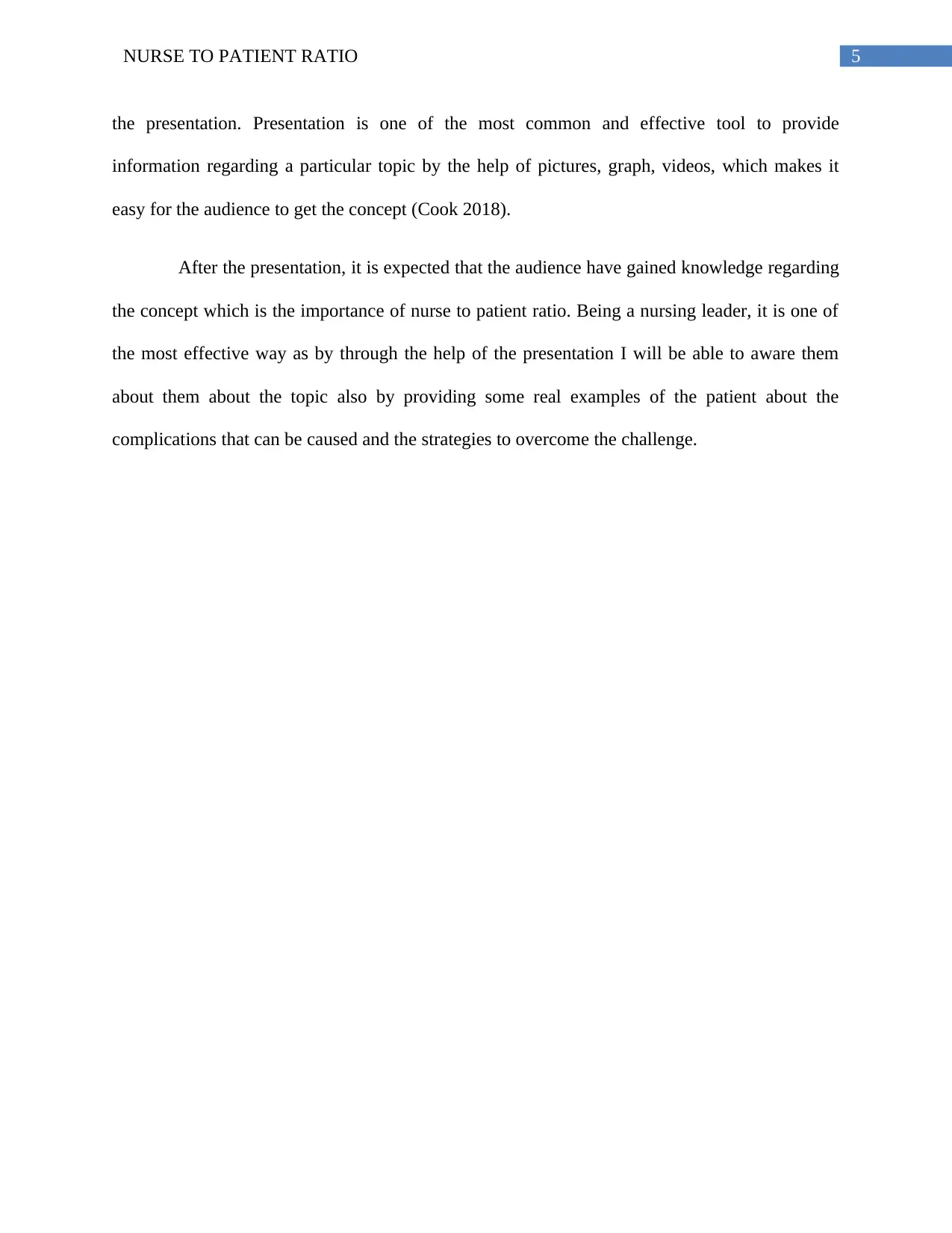
5NURSE TO PATIENT RATIO
the presentation. Presentation is one of the most common and effective tool to provide
information regarding a particular topic by the help of pictures, graph, videos, which makes it
easy for the audience to get the concept (Cook 2018).
After the presentation, it is expected that the audience have gained knowledge regarding
the concept which is the importance of nurse to patient ratio. Being a nursing leader, it is one of
the most effective way as by through the help of the presentation I will be able to aware them
about them about the topic also by providing some real examples of the patient about the
complications that can be caused and the strategies to overcome the challenge.
the presentation. Presentation is one of the most common and effective tool to provide
information regarding a particular topic by the help of pictures, graph, videos, which makes it
easy for the audience to get the concept (Cook 2018).
After the presentation, it is expected that the audience have gained knowledge regarding
the concept which is the importance of nurse to patient ratio. Being a nursing leader, it is one of
the most effective way as by through the help of the presentation I will be able to aware them
about them about the topic also by providing some real examples of the patient about the
complications that can be caused and the strategies to overcome the challenge.
⊘ This is a preview!⊘
Do you want full access?
Subscribe today to unlock all pages.

Trusted by 1+ million students worldwide
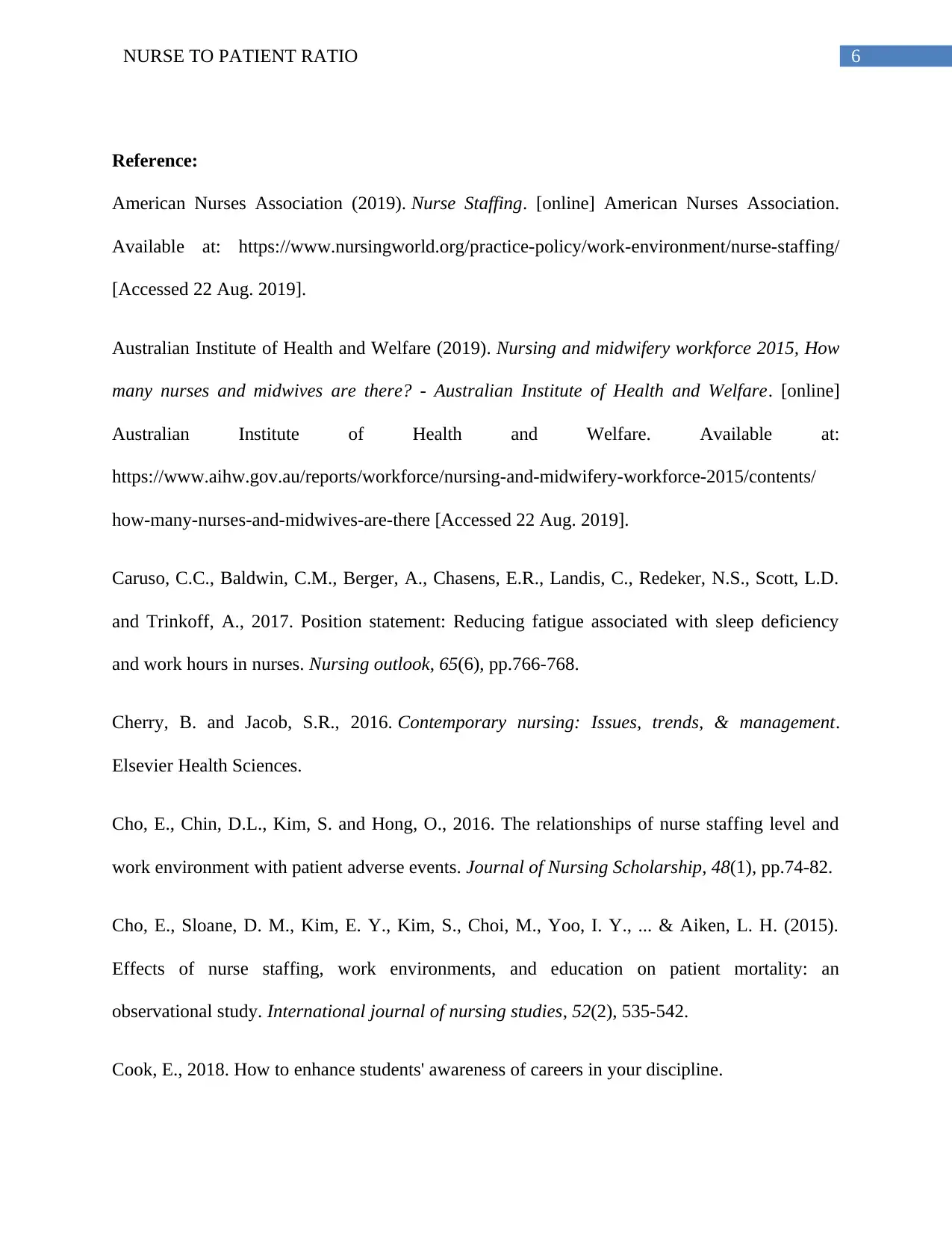
6NURSE TO PATIENT RATIO
Reference:
American Nurses Association (2019). Nurse Staffing. [online] American Nurses Association.
Available at: https://www.nursingworld.org/practice-policy/work-environment/nurse-staffing/
[Accessed 22 Aug. 2019].
Australian Institute of Health and Welfare (2019). Nursing and midwifery workforce 2015, How
many nurses and midwives are there? - Australian Institute of Health and Welfare. [online]
Australian Institute of Health and Welfare. Available at:
https://www.aihw.gov.au/reports/workforce/nursing-and-midwifery-workforce-2015/contents/
how-many-nurses-and-midwives-are-there [Accessed 22 Aug. 2019].
Caruso, C.C., Baldwin, C.M., Berger, A., Chasens, E.R., Landis, C., Redeker, N.S., Scott, L.D.
and Trinkoff, A., 2017. Position statement: Reducing fatigue associated with sleep deficiency
and work hours in nurses. Nursing outlook, 65(6), pp.766-768.
Cherry, B. and Jacob, S.R., 2016. Contemporary nursing: Issues, trends, & management.
Elsevier Health Sciences.
Cho, E., Chin, D.L., Kim, S. and Hong, O., 2016. The relationships of nurse staffing level and
work environment with patient adverse events. Journal of Nursing Scholarship, 48(1), pp.74-82.
Cho, E., Sloane, D. M., Kim, E. Y., Kim, S., Choi, M., Yoo, I. Y., ... & Aiken, L. H. (2015).
Effects of nurse staffing, work environments, and education on patient mortality: an
observational study. International journal of nursing studies, 52(2), 535-542.
Cook, E., 2018. How to enhance students' awareness of careers in your discipline.
Reference:
American Nurses Association (2019). Nurse Staffing. [online] American Nurses Association.
Available at: https://www.nursingworld.org/practice-policy/work-environment/nurse-staffing/
[Accessed 22 Aug. 2019].
Australian Institute of Health and Welfare (2019). Nursing and midwifery workforce 2015, How
many nurses and midwives are there? - Australian Institute of Health and Welfare. [online]
Australian Institute of Health and Welfare. Available at:
https://www.aihw.gov.au/reports/workforce/nursing-and-midwifery-workforce-2015/contents/
how-many-nurses-and-midwives-are-there [Accessed 22 Aug. 2019].
Caruso, C.C., Baldwin, C.M., Berger, A., Chasens, E.R., Landis, C., Redeker, N.S., Scott, L.D.
and Trinkoff, A., 2017. Position statement: Reducing fatigue associated with sleep deficiency
and work hours in nurses. Nursing outlook, 65(6), pp.766-768.
Cherry, B. and Jacob, S.R., 2016. Contemporary nursing: Issues, trends, & management.
Elsevier Health Sciences.
Cho, E., Chin, D.L., Kim, S. and Hong, O., 2016. The relationships of nurse staffing level and
work environment with patient adverse events. Journal of Nursing Scholarship, 48(1), pp.74-82.
Cho, E., Sloane, D. M., Kim, E. Y., Kim, S., Choi, M., Yoo, I. Y., ... & Aiken, L. H. (2015).
Effects of nurse staffing, work environments, and education on patient mortality: an
observational study. International journal of nursing studies, 52(2), 535-542.
Cook, E., 2018. How to enhance students' awareness of careers in your discipline.
Paraphrase This Document
Need a fresh take? Get an instant paraphrase of this document with our AI Paraphraser
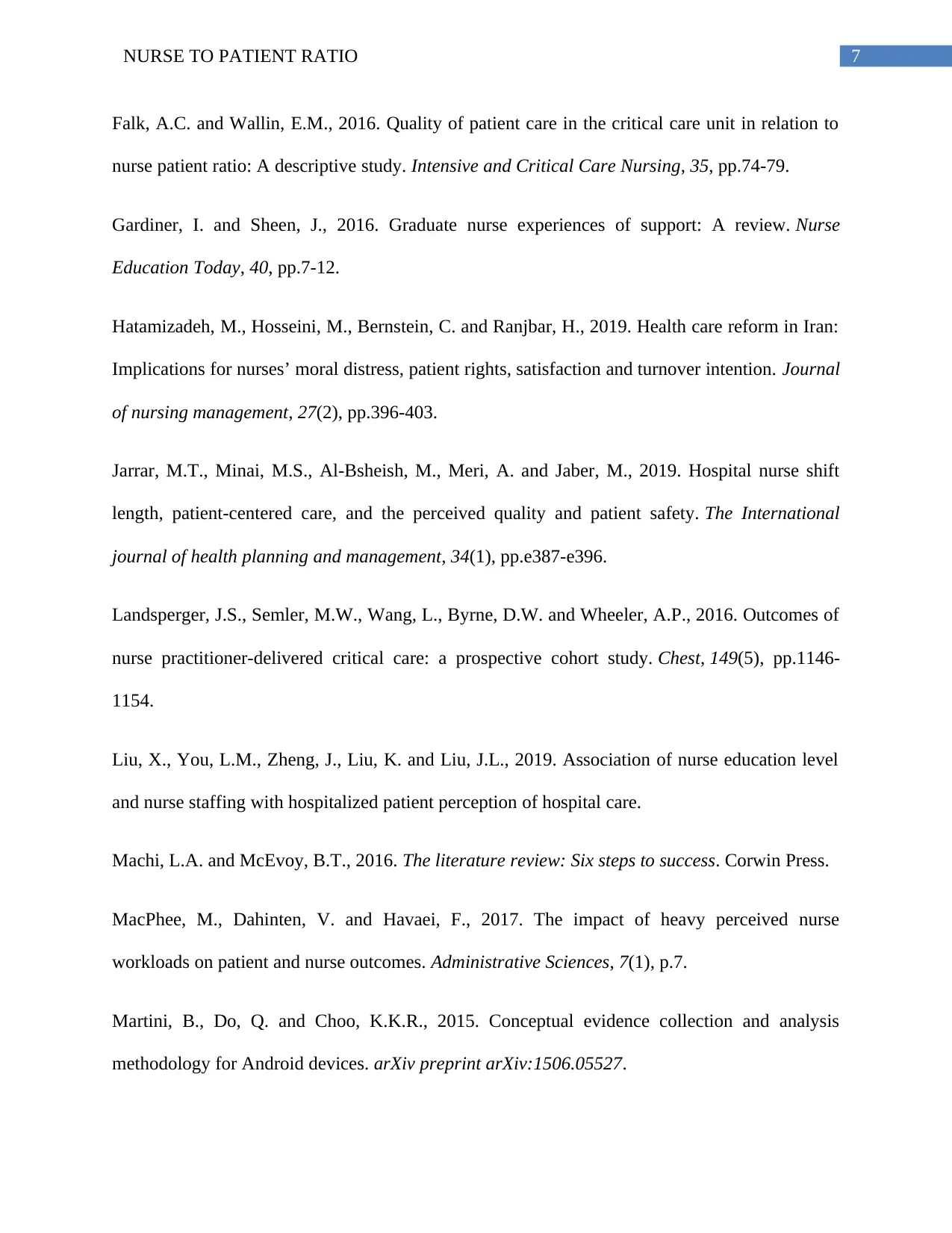
7NURSE TO PATIENT RATIO
Falk, A.C. and Wallin, E.M., 2016. Quality of patient care in the critical care unit in relation to
nurse patient ratio: A descriptive study. Intensive and Critical Care Nursing, 35, pp.74-79.
Gardiner, I. and Sheen, J., 2016. Graduate nurse experiences of support: A review. Nurse
Education Today, 40, pp.7-12.
Hatamizadeh, M., Hosseini, M., Bernstein, C. and Ranjbar, H., 2019. Health care reform in Iran:
Implications for nurses’ moral distress, patient rights, satisfaction and turnover intention. Journal
of nursing management, 27(2), pp.396-403.
Jarrar, M.T., Minai, M.S., Al‐Bsheish, M., Meri, A. and Jaber, M., 2019. Hospital nurse shift
length, patient‐centered care, and the perceived quality and patient safety. The International
journal of health planning and management, 34(1), pp.e387-e396.
Landsperger, J.S., Semler, M.W., Wang, L., Byrne, D.W. and Wheeler, A.P., 2016. Outcomes of
nurse practitioner-delivered critical care: a prospective cohort study. Chest, 149(5), pp.1146-
1154.
Liu, X., You, L.M., Zheng, J., Liu, K. and Liu, J.L., 2019. Association of nurse education level
and nurse staffing with hospitalized patient perception of hospital care.
Machi, L.A. and McEvoy, B.T., 2016. The literature review: Six steps to success. Corwin Press.
MacPhee, M., Dahinten, V. and Havaei, F., 2017. The impact of heavy perceived nurse
workloads on patient and nurse outcomes. Administrative Sciences, 7(1), p.7.
Martini, B., Do, Q. and Choo, K.K.R., 2015. Conceptual evidence collection and analysis
methodology for Android devices. arXiv preprint arXiv:1506.05527.
Falk, A.C. and Wallin, E.M., 2016. Quality of patient care in the critical care unit in relation to
nurse patient ratio: A descriptive study. Intensive and Critical Care Nursing, 35, pp.74-79.
Gardiner, I. and Sheen, J., 2016. Graduate nurse experiences of support: A review. Nurse
Education Today, 40, pp.7-12.
Hatamizadeh, M., Hosseini, M., Bernstein, C. and Ranjbar, H., 2019. Health care reform in Iran:
Implications for nurses’ moral distress, patient rights, satisfaction and turnover intention. Journal
of nursing management, 27(2), pp.396-403.
Jarrar, M.T., Minai, M.S., Al‐Bsheish, M., Meri, A. and Jaber, M., 2019. Hospital nurse shift
length, patient‐centered care, and the perceived quality and patient safety. The International
journal of health planning and management, 34(1), pp.e387-e396.
Landsperger, J.S., Semler, M.W., Wang, L., Byrne, D.W. and Wheeler, A.P., 2016. Outcomes of
nurse practitioner-delivered critical care: a prospective cohort study. Chest, 149(5), pp.1146-
1154.
Liu, X., You, L.M., Zheng, J., Liu, K. and Liu, J.L., 2019. Association of nurse education level
and nurse staffing with hospitalized patient perception of hospital care.
Machi, L.A. and McEvoy, B.T., 2016. The literature review: Six steps to success. Corwin Press.
MacPhee, M., Dahinten, V. and Havaei, F., 2017. The impact of heavy perceived nurse
workloads on patient and nurse outcomes. Administrative Sciences, 7(1), p.7.
Martini, B., Do, Q. and Choo, K.K.R., 2015. Conceptual evidence collection and analysis
methodology for Android devices. arXiv preprint arXiv:1506.05527.
1 out of 8
Related Documents
Your All-in-One AI-Powered Toolkit for Academic Success.
+13062052269
info@desklib.com
Available 24*7 on WhatsApp / Email
![[object Object]](/_next/static/media/star-bottom.7253800d.svg)
Unlock your academic potential
Copyright © 2020–2025 A2Z Services. All Rights Reserved. Developed and managed by ZUCOL.





